BUICK ROADMASTER 1993 Owners Manual
Manufacturer: BUICK, Model Year: 1993, Model line: ROADMASTER, Model: BUICK ROADMASTER 1993Pages: 340, PDF Size: 18.34 MB
Page 191 of 340
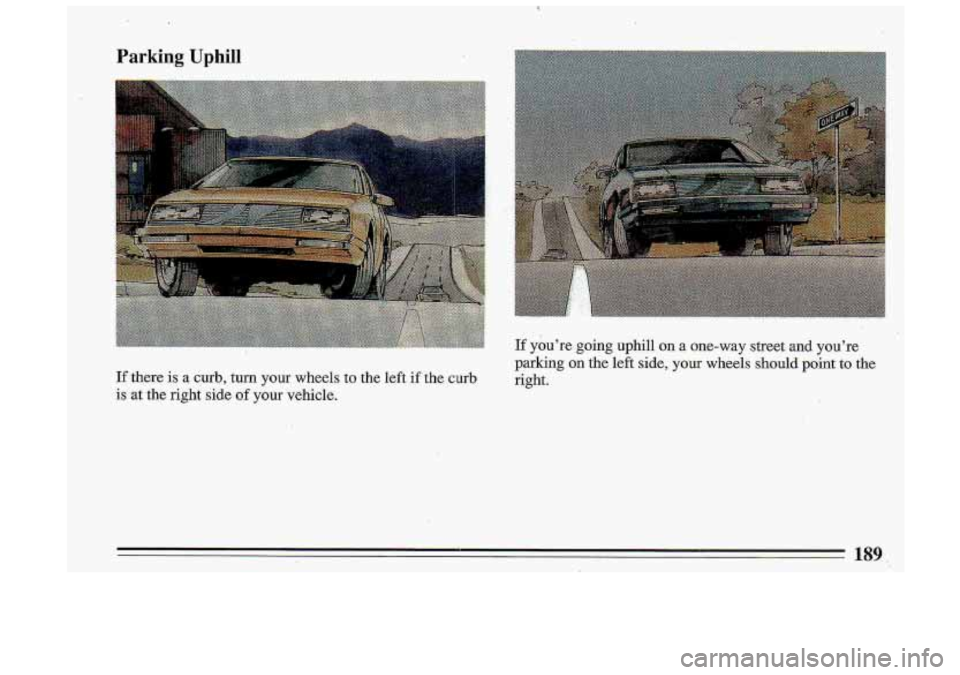
I'
Parking Uphill
I I
If you're going uphill on a one-way street and you're
Ifthere
is a curb, turn your wheels to the left if the curb
is at the right side of your vehicle. parking
on the left
side, your wheels should point to the
right.
189 ,.
Page 192 of 340
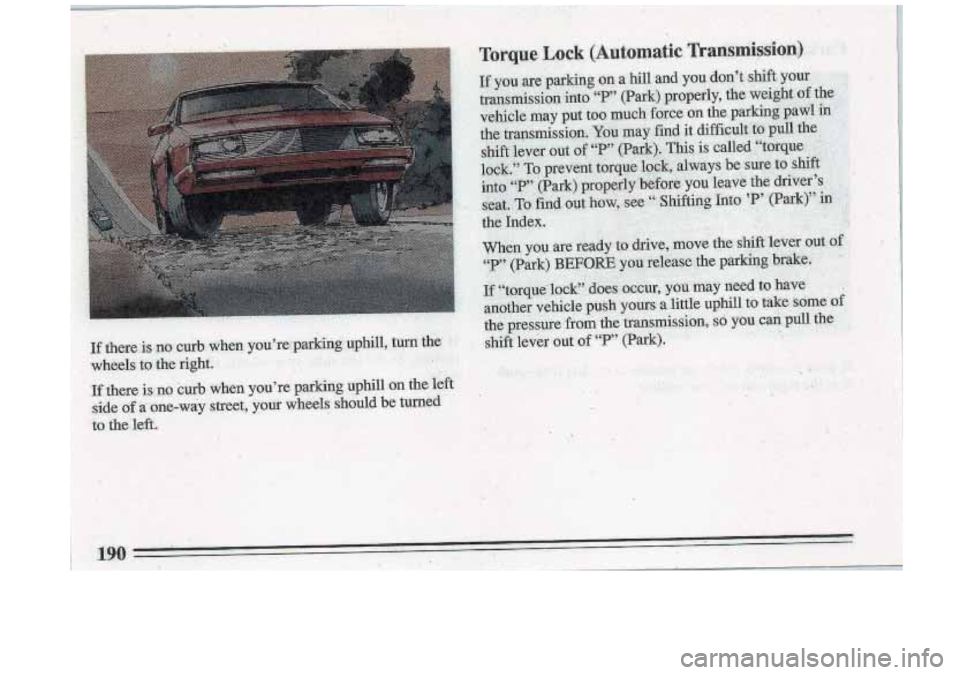
Page 193 of 340
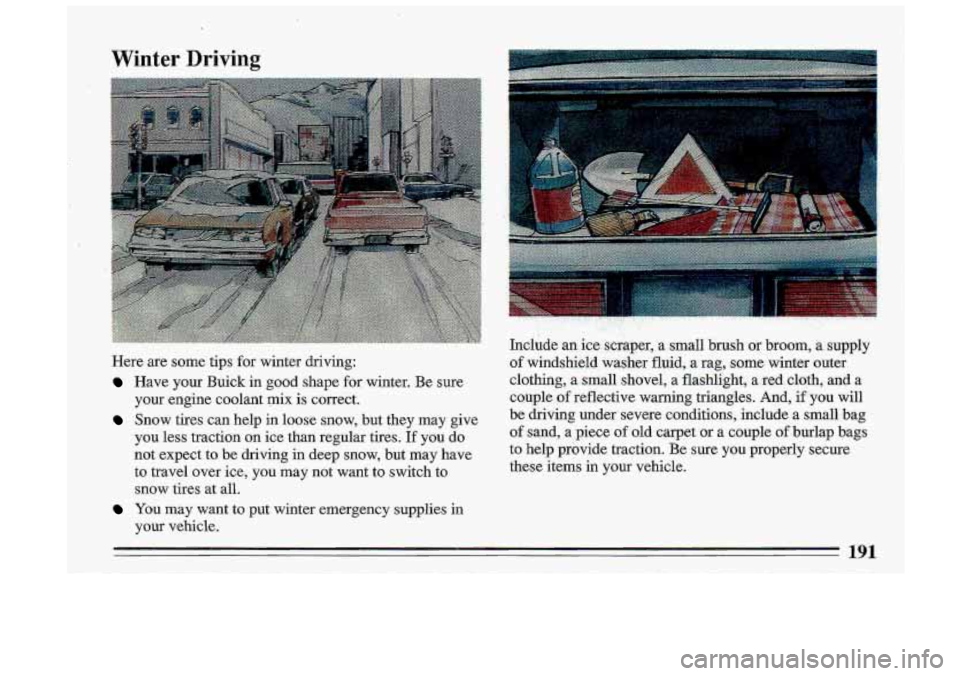
Winter Driving
Here are some tips for winter driving:
Have your Buick in good shape for winter. Be sure
your engine coolant mix is co-rrect.
Snow tires. can help in loose snow, but they may give
you less traction on ice than regular tires. If you do
not expect to be driving
in deep snow, but may have
to travel over ice,
you may not want to switch to
snow tires at all.
You may want to put winter emergency supplies in
your vehicle.
I
I
.. . ..
Include an.ice:scrapGq a small brush .or broom, a supply
of'windshield washer fluid,
a rag, some winter outer
clothing,
a small shovel, a flashlight, a, red. cloth,. and a
couple
.of reflective warning triangles. And, if you will
be driving under:severe conditions, include a small bag
of sand, a piece of ,old carpel .or a couple of burlap. bags
to help provide traction. Be sure y.ou properly secure
these items in your vehicle.
Page 194 of 340
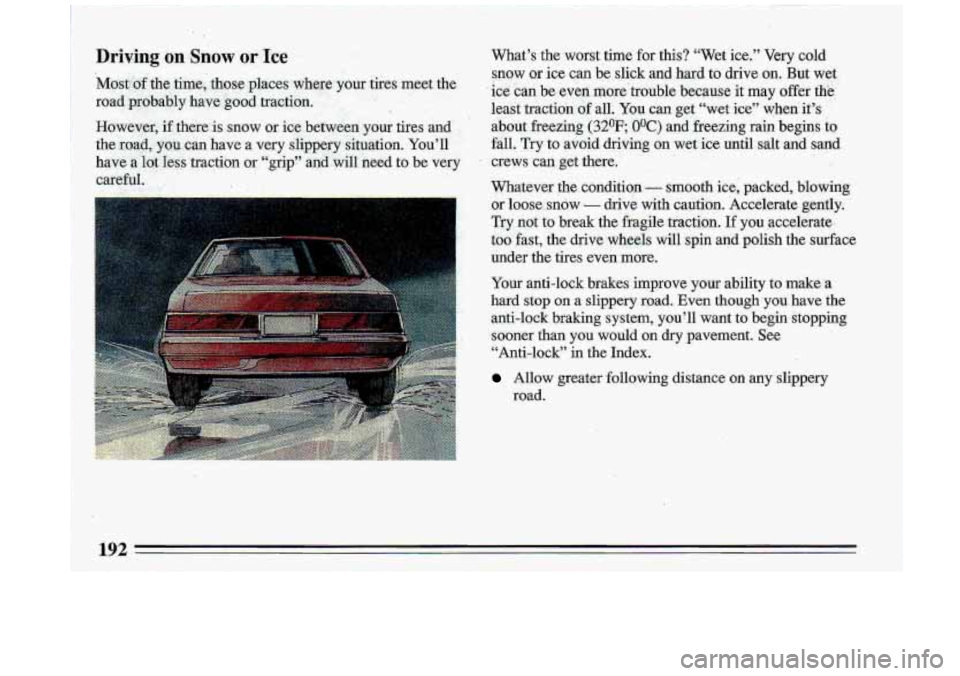
D.riving on Snow or Ice What’s the worst time for this? “Wet ice.” Very cold
snow or ice c.an be slick and hard to drive
on, But wet
ice can be even more’trouble because it may offer
the.
leait traction of all. You can get “wet ice” when’ it’s , ’
about freezing (3ZoF..O0C) and freezing rain begins to
fail. Try to avoid driving on we1 ice until salt and sand
crews can get there.
,.
Whatever the conditio,n - smooth ice, packed, blowing
or loose. snow
.- drive with caution. Accelerate gently.
Try .not
to break the fragile traction. If you accelerate,,
too fast, the drive wheels will spin and polish the surface
under the tires even more.
Your anti-lock brakes improve your ability to make. a
hard stop on a slippery road. Even though you have the
anti-lock braking system, you’ll want to begin-stopping
sooner than you would on dry pavement. See “Anti-lock” in the Index.
Allow greater following distance on any slippery
road.
Page 195 of 340
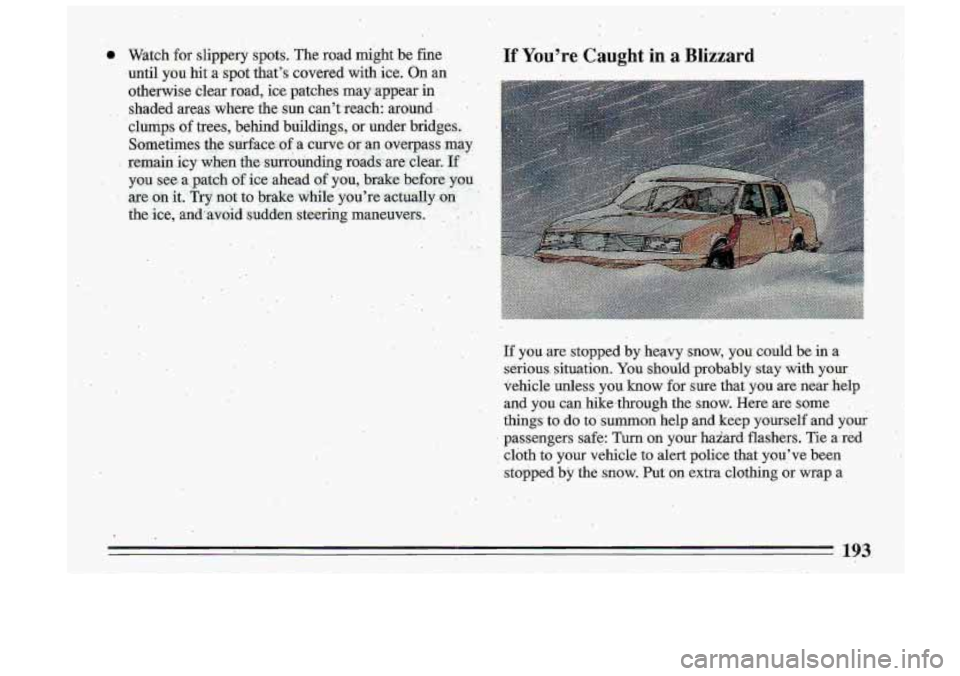
If you are stopped by .heavy snow, you could be-.in a
seirious. situation. You should probably stay with'your
vehicle'unless you. know
for sure that..you are near .help
and yau can hikethrough
the snow. Here are some
things'
to do to summon help and keep yourself and your
passengers safe: Turn on your hazard-flashers. Tie a red
cloth to
your vehicle to alert police that you,'ve been
stopped
by the snow. Put on extra clothing or wrap .a
193
Page 196 of 340
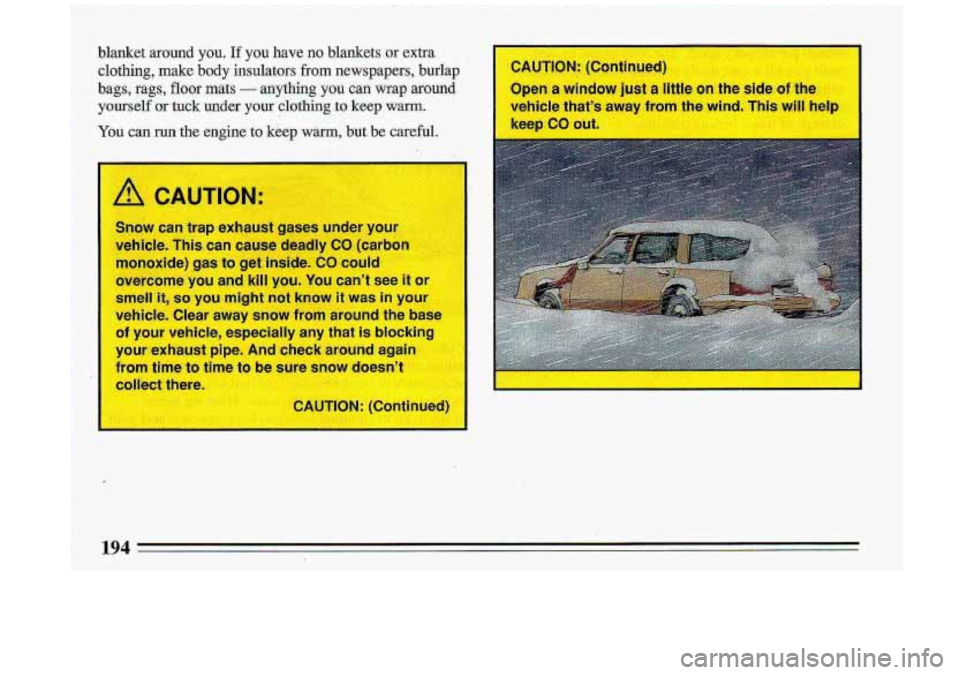
blanket around you. If you have no blankets or extra. II
clothing, make body insulators. from newspapers, burlap I CAUTION: (Continued)
bags, rags, floor math - anything you can wrap around 3pen a window just a Iihz oh &he side of the
yourself OX tuck under your clothing to keep warm. ._ .. ,... r’ ,. . I vehicle that’s away from the wind. This will helr
Yon can run the engine to keep warm, but. be careful.
,. ,
/A CAUTION:
Snow can trap exhaust gases under your
vehicle. This can
cause deadly CO (carbnn
monoxide)
gas to get inside. CQ could
overcome you and kill you. You can’t see it o
smell it, so y~u might not know it was in you1
vehicle. Clear
away snow from around the base
of your vehicle, especially any that is blockina
your exhaust
gibe. And check around again
from time to ti P to be sure snow doesn’t
collect there.
CAUTION: (Continued)
Page 197 of 340
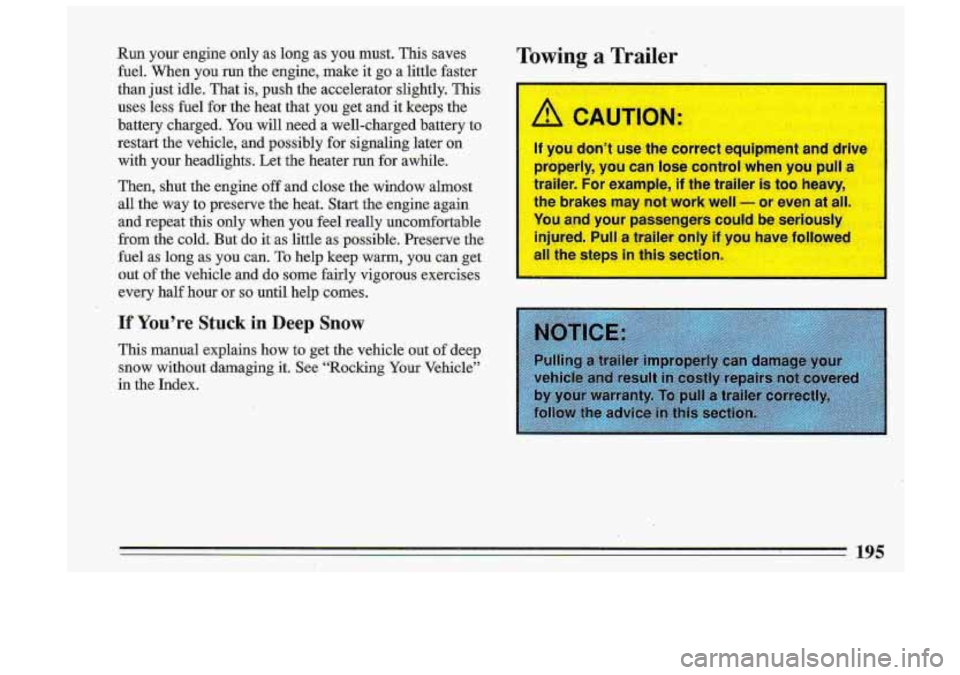
Run your engine only as long as you must. This saves
fuel. When you
run the engine, make it go a little faster
than just idle. That is, push the accelerator slightly. This:
uses less fuel for the heat that you get and it keeps the
battery charged.
You will need a well-charged battery to
restart the vehicle, and possibly for signaling later
on
with your headlights. Let the heater run for awhile.
Then, shut the engine
off and close the window almost
all the way to preserve the heat. Start the engine again
and repeat this only when you feel really uncomfortable
from the cold. But do
it as 'little as possible. Preserve the
fuel
as long as you can. To help keep warm, you can get
out of the vehicle and
do some fairly vigorous exercises
every half hour or
so until help comes.
Towing, a Trailer
/! CAUTION-
If you don't use the correct equipment and drive
properly, you can lose control when you
pull a
trailer.
For example, if the trailer is too heavy,
I the brakes may not work well - or even at all,
You and your passengers could be seriously'
injured. Pull
a trailer only if you have followed
I the steps in this section.
Page 198 of 340
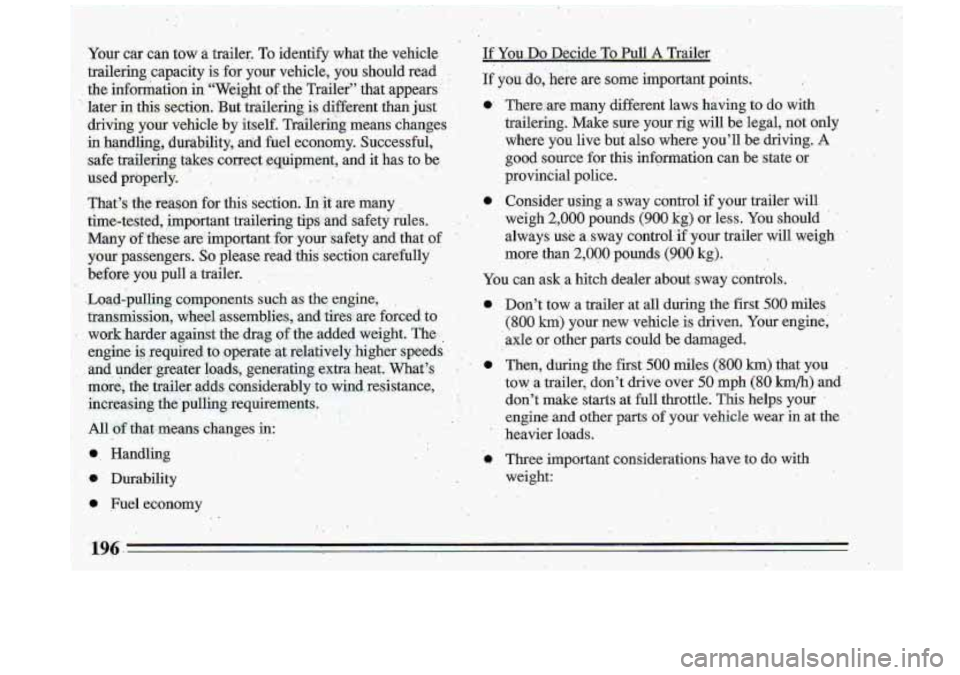
1:
Page 199 of 340
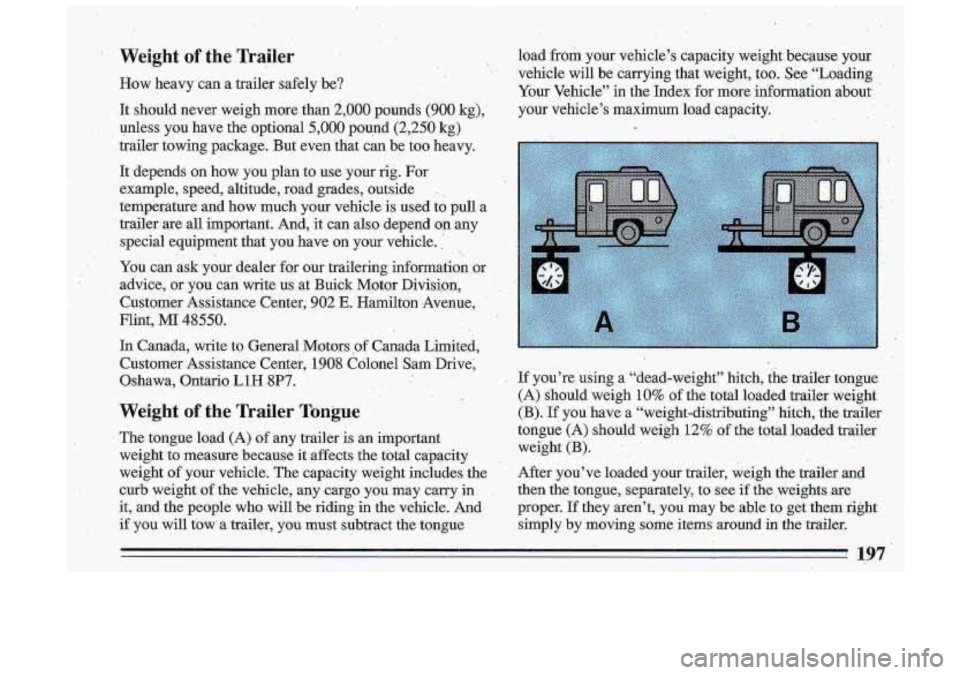
Weight of the Trailer
How heavy can a trailer safely be? load from
your vehicle’s capacity weight because your
vehicle will be carrying that weight, too. See “Loading
’
Your Vehicle” in the Index for more information about
,.
It should never weigh more than 2,000 pounds (900 kg), your vehicle’s maximum load capacity.
unless you have the optional
5,000 pound (2,250 kg)
trailer towing package. But even that can be too heavy.
,.
. . 8:
It -depends on how you plan to .use your rig. For
example, speed, altitude,,road grades, outside
. . .
temperatuie and how much your vehicle is us.ed to pull a
trailer ‘are .all important. And,
it can also depen‘d on any
special equipment that you have on your vehicle.
.’
You can ask your dealer for our traiIering information or
advice, or
you can write us at Buick Motor Division,
Customer Assistance .Center;
902 E. Hamilton Avenue,
Flint,
M.148550.
,.
In Canada, write to General Motors ,of Canada Limited,
Customer Assistance Center, 1908 Colonel Sam. Drive,
Qshawa, Ontario
LlH 8P7.
Weight of the Trailer Tongue
The tongue load (A) -of any trailer is an important
weight to measure because it affects the total capacity
weight of your vehicle. The capacity weight includes ‘the
curb weight’ of the vehicle, any cargo you may carry in
it, and the people who will .be riding in the vehicle. And
if you will
~QW a trailer, you must subtract the tongue
If you’re using a “dead-weight” hitch, the trailer tongue
(A) should weigh 10% of the total loaded trailer weight
(B).
If you have a “weight-distributing” hitch, the trailer
tongue
(A) should weigh 12% of the total loaded trailer
weight
(B). - ’
After you’ve lo,aded.your trailer, weigh the trailer and
then the tongue, separately,
to. see if the weights are
proper. If they aren’t, you may be able’ to get them tight
simply by moving some
items around in the trailer.
Page 200 of 340
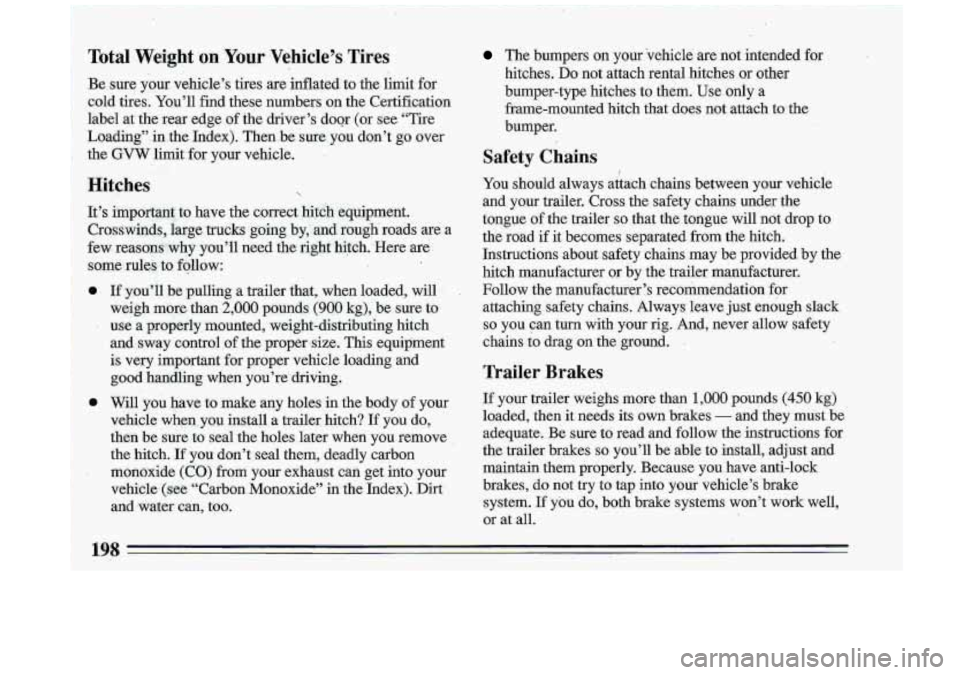
Total Weight on Your Vehicle’s Tires
Be sure your vehicle’s tires are inflated to the limit for
cold tires. You’ll find these numbers on the Certification
label at the rear edge
of the driver’s doqr (or see “Tire
Loading” in the Index). Then be sure you don’t go over
the
GVW limit for your vehicle.
Hitches
It’s important to have the correct hitch equipment.
Crosswinds, large trucks going by, and rough roads are
a
few reasons why you’ll need the right hitch. Here are
some rules to follow:
0
0
If you’ll be pulling a trailer that, when loaded, will
weigh more than
2,000 pounds (900 kg), be sure to
use a properly mounted, weight-distributing hitch
and sway control of the proper size. This equipment
is very important for proper vehicle loading and
good handling when you’re driving.
Will you have to make any holes in the body of your
vehicle when you install
a trailer hitch? If you do,
then be sure to seal the holes later when you remove
the hitch. If you don’t seal them, deadly carbon
monoxide (CO) from your exhaust can get into your
vehicle (see “Carbon Monoxide” in the Index). Dirt
and water can, too.
The bumpers on your vehicle are not intended for
hitches.
Do not attach rental hitches or other
bumper-type hitches to them. Use only a
frame-mounted hitch that does not attach to the
bumper.
Safety Chains
You should always attach chains between your vehicle
and your trailer. Cross the safety chains under the
tongue of the trailer
so that the tongue will not drop to
the road
if it becomes separated from the hitch.
Instructions about safety chains may be provided by the
hitch manufacturer or by the trailer manufacturer.
Follow the manufacturer’s recommendation for
attaching safety chains. Always leave just enough slack
so you can turn with your rig. And, never allow safety
chains
to drag on the ground.
Trailer Brakes
If your trailer weighs more than 1,000 pounds (450 kg)
loaded, then it needs its own brakes
- and they must be
adequate. Be sure to read and follow the instructions for
the trailer brakes
so you’ll be able to install, adjust and
maintain them properly. Because you have anti-lock
brakes, do not try to tap into your vehicle’s brake
system.
If you do, both brake systems won’t work well,
or at all.
198